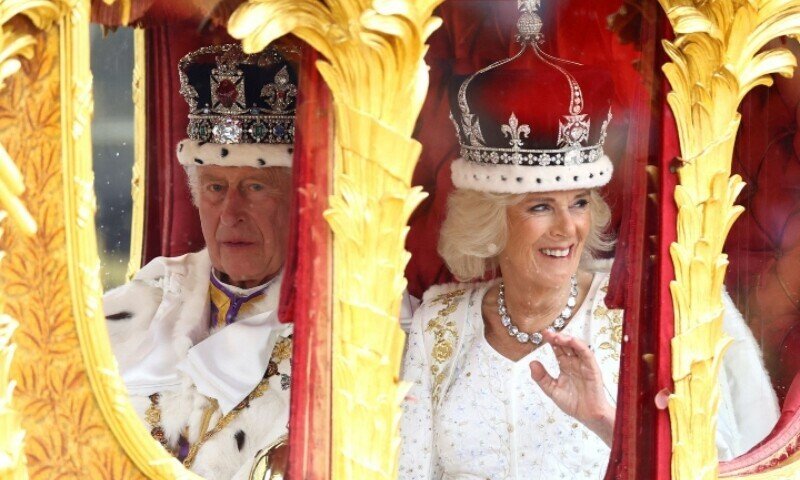King Charles III was anointed and crowned on Saturday in Britain’s biggest ceremonial event for seven decades, a sumptuous display of pageantry dating back 1,000 years.
In front of a congregation of about 100 world leaders and a television audience of millions, the Archbishop of Canterbury, the spiritual leader of the Anglican Church, slowly placed the 360-year-old St Edward’s Crown on Charles’ head as he sat upon a 14th-century throne in Westminster Abbey.
Gun salutes were fired at the Tower of London and across the capital, the nation, in Gibraltar, Bermuda, and on ships at sea. “God save King Charles. Long live King Charles. May the king live forever,” the congregation at the abbey said after a trumpet fanfare.
During the historic and solemn two-hour service, which dates back to the time of William the Conqueror in 1066, Charles’ second wife Camilla was also crowned queen.
While rooted in history, the ceremony – televised for only the second time – is also an attempt to present a forward-looking monarchy, with those involved reflecting a more diverse country and all its religions.
With the nation struggling to find its way in the political maelstrom after its exit from the European Union and maintain its standing in a new world order, the monarchy’s supporters say the royal family provides an international draw, a vital diplomatic tool and a means of keeping Britain on the world stage.
“No other country could put on such a dazzling display – the processions, the pageantry, the ceremonies, and street parties,” Prime Minister Rishi Sunak said.
Despite Sunak’s enthusiasm, the coronation takes place amid a cost of living crisis and public scepticism, particularly among the young, about the role and relevance of the monarchy.
Saturday’s event was on a smaller scale than that staged for Queen Elizabeth in 1953, but still sought to be spectacular, featuring an array of historical regalia from golden orbs and bejewelled swords to a sceptre holding the world’s largest colourless cut diamond.
Charles, 74, automatically succeeded his mother as king on her death last September, and the coronation is not essential but regarded as a means to legitimise the monarch in a public way.
After the service, Charles and Camilla, 75, departed in the four-tonne Gold State Coach built for George III, the last king of Britain’s American colonies, to ride to Buckingham Palace in a one-mile procession of 4,000 military personnel from 39 nations.
Meanwhile hundreds of soldiers in scarlet uniforms and black bearskin hats lined the route along The Mall, the grand boulevard leading to the palace, in what is the largest ceremonial event of its kind in Britain since the coronation of Charles’ mother.
Tens of thousands of people ignored pouring rain to mass in a crowd more than 20 deep in some places to watch what some saw as a moment of history.
“When I was a young girl, I was able to watch (the coronation of) Queen Elizabeth on television in Hartford, Connecticut, at a friend’s house because we had no TV,” said retired U.S. teacher Peggy Jane Laver, 79. “So I’m thrilled to be here for the coronation in person.”
Great and good
Inside the abbey, which was bedecked with flowers and flags, politicians and representatives from Commonwealth nations took their seats alongside charity workers and celebrities, including actors Emma Thompson, Maggie Smith, Judi Dench and U.S. singer Katy Perry.
Charles looked solemn as he swore oaths to govern justly and uphold the Church of England – of which he is the titular head.
People wait to watch Britain’s King Charles’ procession to his coronation ceremony from Buckingham Palace to Westminster Abbey, at The Mall in London, on Saturday. — Reuters
He was then hidden from watching eyes by a screen for the most sacred part of the ceremony when he was anointed on his hands, head and breast by Archbishop of Canterbury Justin Welby with holy oil consecrated in Jerusalem.
After being presented with symbolic regalia, Welby placed the St Edward’s Crown on his head and the congregation cried out “God save the King”.
His eldest son and heir Prince William, 40, then knelt before his father to pledge his loyalty as his “liege man of life and limb”, both moments greeted by cheers from crowds outside.
As he left the abbey, Charles wore a silk and ermine robe.
Much of the ceremony featured elements that Charles’ forebears right back to King Edgar in 973 would recognise, officials said. Handel’s coronation anthem “Zadok The Priest” was sung as it has been at every coronation since 1727.
But there was also the new, including an anthem composed by Andrew Lloyd Webber, famed for his West End and Broadway theatre shows, and a gospel choir.
Charles’ grandson Prince George and the grandchildren of Camilla acted as pages, and at the end there was an “unprecedented” greeting from faith leaders.
However, there was no formal role for either Charles’ younger son Prince Harry, after his high-profile falling out with his family, or his brother Prince Andrew, who was forced to quit royal duties because of his friendship with late U.S. financier Jeffrey Epstein, a convicted sex offender.
They sat in the third row behind working members of the royal family.
Not everyone among the crowds was there to cheer Charles, with hundreds of republicans booing and waving banners reading “Not My King”.
More than 11,000 police were deployed to stamp out any attempted disruption, and the Republic campaign group said its leader Graham Smith had been arrested along with five other protesters.
But they were a minority with most drawn to the occasion by its unique nature or family connections.
Diana Brereton said she had travelled from Toronto in Canada to follow in her grandfather’s footsteps as he had marched as a soldier in the coronation procession for George V in 1911.
“He marched along here and 112 years later I’m here, keeping the family tradition for another king,” she said.
PM Shehbaz meets Prince Charles, British PM Sunak
Meanwhile, Prime Minister Shehbaz Sharif, who is also in the UK to attend the coronation, met with King Charles III and British Prime Minister Rishi Sunak during the Commonwealth leaders’ meeting in London, according to Radio Pakistan.
The premier arrived in London on Wednesday to attend the coronation of King Charles III.
He extended his warm felicitations to both British dignitaries for the impeccable arrangements made for the grandiose two-day coronation ceremonies of the new King.
In addition, he expressed his deep appreciation for the UK’s humanitarian assistance during the devastating floods that wreaked havoc in Pakistan last year.
The prime minister emphasised the need to enhance bilateral relations between the two countries and proposed the establishment of a joint commission to be led by the leaders of both nations.
According to the state-run radio service, King Charles III and Sunak echoed the PM Shehbaz’s enthusiasm for bolstering the bilateral relations between the two nations. They also lauded the Pakistani community residing in the UK for their remarkable contributions towards the growth and development of the UK.
Information Minister Marriyum Aurangzeb also shared a picture of the premier meeting with various dignitaries including President of Sri Lanka Ranil Wickremesinghe on the sidelines of King Charles coronation.
Allegiance
Welby will call for all those in the abbey and across the nation to swear allegiance to Charles — a new element that replaces the homage traditionally sworn by senior dukes and peers of the realm.
However, that has caused controversy, with Republic calling it offensive, forcing Welby to clarify it is an invitation not a command. After returning to Buckingham Palace, the royals will make a traditional appearance on the balcony, with a fly-past by military aircraft.
Also in traditional British fashion, the weather in London could feature heavy bursts of rain, forecasters said.
Celebrations will continue on Sunday with nationwide street parties and a concert at the king’s Windsor Castle home, while volunteering projects will take place on Monday.
“When you see everyone dressed up and taking part it is just fantastic. It makes you so proud,” said teacher Andy Mitchell, 63, who left his house in the early hours to get into London.
“My big concern is that younger people are losing interest in all of this and it won’t be the same in the future.”
‘Six anti-monarchists arrested’
Separately, the UK police have arrested leading members of the anti-monarchy group Republic as they prepared to protest along the route of a procession, the organisation said.
“They’ve arrested six of our organisers and seized hundreds of placards, they won’t tell us why they’ve arrested them or where they’re being held,” a Republic activist told AFP in London’s Trafalgar Square.
Republic chief executive Graham Smith was one of those arrested before the group had a chance to wave placards declaring: “Not My King.” Some onlookers nearby shouted “free Graham Smith!” But others shouted “God save the king” and waved Union flags.
A camera crew from the group Alliance of European Republican Movements was at the scene and asked a senior police officer why the group had been detained.
“They’re under arrest. End of,” the officer told them, walking off.
There was no immediate comment from London’s Metropolitan police force, which was controversially granted new anti-protest powers by the UK government under a new law rushed through this week.

